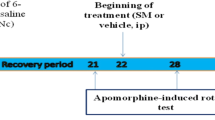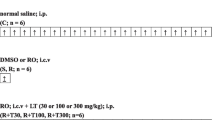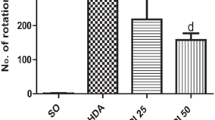Abstract
Parkinson’s disease (PD) is a common and severe neurodegenerative disorder associated with a selective loss of dopaminergic neurons in substantia nigra pars compacta. The crucial role of oxidative stress and inflammation in PD onset and progression is evident. It has been proven that garlic extract (GE) protects the cells from oxidative stress, inflammation, mitochondrial dysfunction and apoptosis. That is, we aimed to investigate if GE reveals protective features on the preclinical model of PD. The study has been designed to evaluate both preventive (GE administered before 6-OHDA injection) and therapeutic (GE administered after 6-OHDA injection) effects of GE on the animal model. Forty male Wistar rats were divided into 4 groups including control, lesion, treatment I (received GE before 6-OHDA injection) and treatment II (received GE both before and after 6-OHDA injection). At the end of treatment, hanging, rotarod, open field and passive avoidance tests as well as immunohistochemistry were performed to evaluate the neuroprotective effects of garlic against PD. Our immunohistochemistry analysis revealed that the tyrosine hydroxylase positive cells (TH+) in GE treated groups were significantly higher (p˂0.001) than the lesion group. The motor deficiency significantly improved in hanging, rotarod, open-field and apomorphine-induced rotational tests. We observed an attenuation in memory impairment induced by PD on GE treated group. Therefore, we found that GE protects dopaminergic neurons in 6-OHDA-induced neurotoxicity and ameliorates movement disorders and behavioral deficits.
Graphical abstract







Similar content being viewed by others
Data availability
All data generated or analyzed during this study are included in this published article.
References
Agbana YL, Ni Y, Zhou M, Zhang Q, Kassegne K, Damintoti Karou S, Kuang Y, Zhu Y (2020) Garlic-derived bioactive compound S-allylcysteine inhibits cancer progression through diverse molecular mechanisms. Nutr Res 73:1–14. https://doi.org/10.1016/j.nutres.2019.11.002
Arab Z, Hosseini M, Mashayekhi F, Anaeigoudari A (2020) Zataria multiflora extract reverses lipopolysaccharide-induced anxiety and depression behaviors in rats. Avicenna J Phytomed 10(1):78–88
Baghishani F, Mohammadipour A, Hosseinzadeh H, Hosseini M, Ebrahimzadeh-Bideskan A (2018) The effects of tramadol administration on hippocampal cell apoptosis, learning and memory in adult rats and neuroprotective effects of crocin. Metab Brain Dis 33(3):907–916. https://doi.org/10.1007/s11011-018-0194-6
Baluchnejadmojarad T, Kiasalari Z, Afshin-Majd S, Ghasemi Z, Roghani M (2017) S-Allyl cysteine ameliorates cognitive deficits in streptozotocin-diabetic rats via suppression of oxidative stress, inflammation, and acetylcholinesterase. Eur J Pharmacol 794:69–76. https://doi.org/10.1016/j.ejphar.2016.11.033
Barata-Antunes S, Teixeira FG, Mendes-Pinheiro B, Domingues AV, Vilaça-Faria H, Marote A, Silva D, Sousa RA, Salgado AJ (2020) Impact of Aging on the 6-OHDA-Induced Rat Model of Parkinson’s Disease. Int J Mol Sci 21(10):3459. https://doi.org/10.3390/ijms21103459
Basu C, Chatterjee A, Bhattacharya S, Dutta N, Sur R (2019) S-allyl Cysteine Inhibits TNF‐α‐induced Inflammation in HaCaT Keratinocytes by Inhibition of NF‐ ΚB‐dependent Gene Expression via Sustained ERK Activation. Exp Dermatol 28(11):1328–1335. https://doi.org/10.1111/exd.14041
Cenini G, Lloret A, Cascella R (2019) Oxidative stress in neurodegenerative diseases: from a mitochondrial point of view. Oxidative Med Cell Longev 2019:2105607. https://doi.org/10.1155/2019/2105607
Chen C, Turnbull DM, Reeve AK (2019) Mitochondrial dysfunction in Parkinson’s disease—cause or consequence? Biology (Basel) 8(2):38. https://doi.org/10.3390/biology8020038
Colín-González AL, Ortiz-Plata A, Villeda-Hernández J, Barrera D, Molina-Jijón E, Pedraza-Chaverrí J, Maldonado PD (2011) Aged garlic extract attenuates cerebral damage and cyclooxygenase-2 induction after ischemia and reperfusion in rats. Plant Foods Hum Nutr 66(4):348–354. https://doi.org/10.1007/s11130-011-0251-3
Dai J, Chen Y, Jiang F (2020) Allicin Reduces Inflammation by regulating ROS/NLRP3 and autophagy in the context of A. Fumigatus infection in mice. Gene 762:145042. https://doi.org/10.1016/j.gene.2020.145042
Ebrahimi V, Aliaghaei A, Piryaei A, Haghir H, Abdollahifar MA, Sadeghi Y (2019) Nigral injection of 6-hydroxydopamine induces changes in spatial arrangement of striatal neuron and glial cells. Front Biosci (Schol Ed) 11:1–8
Ebrahimi V, Eskandarian Boroujeni M, Aliaghaei A, Abdollahifar MA, Piryaei A, Haghir H, Sadeghi Y (2020) Functional dopaminergic neurons derived from human chorionic mesenchymal stem cells ameliorate striatal atrophy and improve behavioral deficits in Parkinsonian rat model. Anat Rec (Hoboken) 303(8):2274–2289. https://doi.org/10.1002/ar.24301
Farooqui T, Farooqui AA (2018) Neuroprotective effects of garlic in model systems of neurodegenerative diseases. Role of the mediterranean diet in the brain and neurodegenerative diseases. Elsevier, Amsterdam, pp 253–269. https://doi.org/10.1016/B978-0-12-811959-4.00016-X
Farshbaf-Khalili A, Mohammadi-Ghalehbin B, Shahnazi M, Asghari S, Javadzadeh Y, Azghani P (2016) Iran Red Crescent Med J 18(12):e29262. https://doi.org/10.5812/ircmj.29262
Farzanegi P, Abbaszadeh H, Farokhi F, Rahmati-Ahmadabad S, Hosseini SA, Ahmad A, Mazandarani MR, Rezaei I, Shokrie M, Vizvari E, Alinejad H, Azarbayjani MA (2020) Attenuated renal and hepatic cells apoptosis following swimming exercise supplemented with garlic extract in old rats. Clin Interv Aging 15:1409–1418. https://doi.org/10.2147/CIA.S250321
Fine JM, Stroebel BM, Faltesek KA, Terai K, Haase L, Knutzen KE, Kosyakovsky J, Bowe TJ, Fuller AK, Frey WH, Hanson LR (2020) Intranasal delivery of low-dose insulin ameliorates motor dysfunction and dopaminergic cell death in a 6-OHDA rat model of Parkinson’s disease. Neurosci Lett 714:134567. https://doi.org/10.1016/j.neulet.2019.134567
Gao W, Wang W, Zhang J, Deng P, Hu J, Yang J, Deng Z (2019) allicin ameliorates obesity comorbid depressive-like behaviors: involvement of the oxidative stress, mitochondrial function, autophagy, insulin resistance and NOX/Nrf2 imbalance in mice. Metab Brain Dis 34(5):1267–1280. https://doi.org/10.1007/s11011-019-00443-y
García Trejo EMÁ, Arellano Buendía AS, Sánchez Reyes O, García Arroyo FE, Arguello García R, Loredo Mendoza ML, Tapia E, Sánchez Lozada LG, Osorio Alonso H (2017) The beneficial effects of allicin in chronic kidney disease are comparable to losartan. Int J Mol Sci 18(9):1980. https://doi.org/10.3390/ijms18091980
Ghasemi S, Hosseini M, Feizpour A, Alipour F, Sadeghi A, Vafaee F, Mohammadpour T, Soukhtanloo M, Ebrahimzadeh Bideskan A, Beheshti F (2017) Beneficial effects of garlic on learning and memory deficits and brain tissue damages induced by lead exposure during juvenile rat growth is comparable to the effect of ascorbic acid. Drug Chem Toxicol 40(2):206–214. https://doi.org/10.1080/01480545.2016.1197238
Ghobadi S, Dastan D, Soleimani M, Nili-Ahmadabadi A (2019) Hepatoprotective potential and antioxidant activity of allium tripedale in acetaminophen-induced oxidative damage. Res Pharm Sci 14(6):488–495. https://doi.org/10.4103/1735-5362.272535
Gonzalez-Rodriguez P, Zampese E, Surmeier DJ (2020) Selective neuronal vulnerability in Parkinson’s disease. Prog Brain Res 252:61–89. https://doi.org/10.1016/bs.pbr.2020.02.005
Guo Y, Wei X, Yan H, Qin Y, Yan S, Liu J, Zhao Y, Jiang F, Lou H (2019) TREM2 deficiency aggravates α-synuclein-induced neurodegeneration and neuroinflammation in Parkinson’s disease models. FASEB J 33(11):12164–12174. https://doi.org/10.1096/fj.201900992R
Haddadi H, Rajaei Z, Alaei H, Shahidani S (2018) Chronic treatment with carvacrol improves passive avoidance memory in a rat model of Parkinson’s disease. Arq Neuro-Psiquiatr 76(2):71–77. https://doi.org/10.1590/0004-282X20170193
Haddadi R, Eyvari-Brooshghalan S, Nayebi AM, Sabahi M, Ahmadi SA (2020) Neuronal degeneration and oxidative stress in the SNc of 6-OHDA intoxicated rats; improving role of silymarin long-term treatment. Naunyn Schmiedeberg's Arch Pharmacol 393(12):2427–2437. https://doi.org/10.1007/s00210-020-01954-7
Haeri P, Mohammadipour A, Heidari Z, Ebrahimzadeh-bideskan A (2019) Neuroprotective effect of crocin on substantia nigra in MPTP-induced parkinson’s disease model of mice. Anat Sci Int 94(1):119–127. https://doi.org/10.1007/s12565-018-0457-7
Heidari Z, Mohammadipour A, Haeri P, Ebrahimzadeh-bideskan A (2019) The effect of titanium dioxide nanoparticles on mice midbrain substantia nigra. Iran J Basic Med Sci 22(7):745–751. https://doi.org/10.22038/ijbms.2019.33611.8018
Hwang KA, Hwang YJ, Hwang IG, Song J, Jun Kim Y (2019) Low temperature-aged garlic extract suppresses psychological stress by modulation of stress hormones and oxidative stress response in brain. J Chin Med Assoc 82(3):191–195. https://doi.org/10.1097/JCMA.0000000000000028
Jalayeri-Darbandi Z, Rajabzadeh A, Hosseini M, Beheshti F, Ebrahimzadeh-Bideskan A (2018) The effect of methamphetamine exposure during pregnancy and lactation on hippocampal doublecortin expression, learning and memory of rat offspring. Anat Sci Int 93(3):351–363. https://doi.org/10.1007/s12565-017-0419-5
Javad H, Seyed-Mostafa HZ, Farhad O, Mehdi M, Ebrahim AO, Nader RG, Ramin GS, Behrooz H (2012) Hepatoprotective effects of hydroalcoholic extract of Allium hirtifolium (Persian shallot) in diabetic rats. J Basic Clin Physiol Pharmacol 23(2):83–87. https://doi.org/10.1515/jbcpp-2012-0017
Jung HY, Lee KY, Yoo DY, Kim JW, Yoo M, Lee S, Yoo KY, Yoon YS, Choi JH, Hwang IK (2016) Essential oils from two allium species exert effects on cell proliferation and neuroblast differentiation in the mouse dentate gyrus by modulating brain-derived neurotrophic factor and acetylcholinesterase. BMC Complement Altern Med 16(1):431. https://doi.org/10.1186/s12906-016-1384-6
Khajevand-Khazaei MR, Azimi S, Sedighnejad L, Salari S, Ghorbanpour A, Baluchnejadmojarad T, Mohseni-Moghaddam P, Khamse S, Roghani M (2019) S-allyl cysteine protects against lipopolysaccharide-induced acute kidney injury in the C57BL/6 mouse strain: involvement of oxidative stress and inflammation. Int Immunopharmacol 69:19–26. https://doi.org/10.1016/j.intimp.2019.01.026
Kong X, Gong S, Su L, Li C, Kong Y (2017) Neuroprotective effects of allicin on ischemia-reperfusion brain injury. Oncotarget 8(61):104492–104507. https://doi.org/10.18632/oncotarget.22355
Kumari N, Agrawal S, Kumari R, Sharma D, Luthra PM (2018) Neuroprotective effect of IDPU (1-(7-Imino-3-Propyl-2,3-Dihydrothiazolo [4,5-d]Pyrimidin-6(7H)-Yl)Urea) in 6-OHDA induced rodent model of Hemiparkinson’s disease. Neurosci Lett 675:74–82. https://doi.org/10.1016/j.neulet.2018.03.040
Lee HJ, Yoon DK, Lee NY, Lee CH (2019) Effect of aged and fermented garlic extracts as natural antioxidants on lipid oxidation in pork patties. Food Sci Anim Resour 39(4):610–622. https://doi.org/10.5851/kosfa.2019.e51
Liu H, Mao P, Wang J, Wang T, Xie CH (2015) Allicin protects PC12 cells against 6-OHDA induced oxidative stress and mitochondrial dysfunction via regulating mitochondrial dynamics. Cell Physiol Biochem 36(3):966–979. https://doi.org/10.1159/000430271
Liu J, Wang X, Lu Y, Duan C, Gao G, Lu L, Yang H (2017) Pink1 interacts with α-synuclein and abrogates α-synuclein-induced neurotoxicity by activating autophagy. Cell Death Dis 8(9):e3056. https://doi.org/10.1038/cddis.2017.427
Manchanda S, Singh H, Kaur T, Kaur G (2018) Low-grade neuroinflammation due to chronic sleep deprivation results in anxiety and learning and memory impairments. Mol Cell Biochem 449(1–2):63–72. https://doi.org/10.1007/s11010-018-3343-7
Marin C, Bonastre M, Fuentes M, Mullol J (2020) Globus pallidus, but not entopeduncular nucleus, 6-OHDA-induced lesion attenuates L-Dopa-induced dyskinesia in the rat model of Parkinson’s disease. Pharmacol Biochem Behav 197:173013. https://doi.org/10.1016/j.pbb.2020.173013
Mathew B, Biju R (2008) Neuroprotective effects of garlic a review. Libyan J Med 3(1):23–33. https://doi.org/10.3402/ljm.v3i1.4747
Mohammadipour A, Haghir H, Ebrahimzadeh-Bideskan A (2020) A link between nanoparticles and Parkinson’s disease. Which nanoparticles are most harmful? Rev Environ Health. 2020 Jul 20. /j/reveh.ahead-of-print/reveh-2020-0043/reveh-2020-0043.xml, https://doi.org/10.1515/reveh-2020-0043
Mu J, Chaudhuri KR, Bielza C, de Pedro-Cuesta J, Larrañaga P, Martinez-Martin P (2017) Parkinson’s disease subtypes identified from cluster analysis of motor and non-motor symptoms. Front Aging Neurosci 9(SEP):301. https://doi.org/10.3389/fnagi.2017.00301
Mumtaz S, Ali S, Khan R, Shakir HA, Tahir HM, Mumtaz S, Andleeb S (2020) Therapeutic role of garlic and vitamins C and E against toxicity induced by lead on various organs. Environ Sci Pollut Res 27(9):8953–8964. https://doi.org/10.1007/s11356-020-07654-2
Nillert N, Pannangrong W, Welbat JU, Chaijaroonkhanarak W, Sripanidkulchai K, Sripanidkulchai B (2017) Neuroprotective effects of aged garlic extract on cognitive dysfunction and neuroinflammation induced by β-amyloid in rats. Nutrients 9(1):24. https://doi.org/10.3390/nu9010024
Orabi SH, Abd Eldaium D, Hassan A, Sabagh HSE, Abd Eldaim MA (2020) Allicin modulates diclofenac sodium induced hepatonephro toxicity in rats via reducing oxidative stress and caspase 3 protein expression. Environ Toxicol Pharmacol 74:103306. https://doi.org/10.1016/j.etap.2019.103306
Palakurthi B, Burugupally SP (2019) Postural instability in Parkinson’s disease: a review. Brain Sciences 9(9):239. https://doi.org/10.3390/brainsci9090239
Pang SY, Ho PW, Liu HF, Leung CT, Li L, Chang EES, Ramsden DB, Ho SL (2019) The interplay of aging, genetics and environmental factors in the pathogenesis of Parkinson’s disease. Transl Neurodegener 8:23. https://doi.org/10.1186/s40035-019-0165-9
Rastegar-Moghaddam SH, Mohammadipour A, Hosseini M, Bargi R, Ebrahimzadeh-Bideskan A (2019) Maternal exposure to atrazine induces the hippocampal cell apoptosis in mice offspring and impairs their learning and spatial memory. Toxin Rev 38(4):298–306. https://doi.org/10.1080/15569543.2018.1466804
Renko JM, Bäck S, Voutilainen MH, Piepponen TP, Reenilä I, Saarma M, Tuominen RK (2018) Mesencephalic astrocyte-derived neurotrophic factor (MANF) elevates stimulus-evoked release of dopamine in freely-moving rats. Mol Neurobiol 55(8):6755–6768. https://doi.org/10.1007/s12035-018-0872-8
Sarukhani M, Haghdoost-Yazdi H, Sarbazi Golezari A, Babayan-Tazehkand A, Dargahi T, Rastgoo N (2018) Evaluation of the antiparkinsonism and neuroprotective effects of hydrogen sulfide in acute 6-hydroxydopamine-induced animal model of Parkinson’s disease: behavioral, histological and biochemical studies. Neurol Res 40(7):523–531. https://doi.org/10.1080/01616412.2017.1390903
Sayed AA, El-Desouky MA, Ibrahim KA (2019) Garlic and allopurinol attenuate hepatic apoptosis induced by fipronil in male albino rats. Regul Toxicol Pharmacol 107:104400. https://doi.org/10.1016/j.yrtph.2019.05.025
Song H, Cui J, Mossine VV, Greenlief CM, Fritsche K, Sun GY, Gu Z (2019) Bioactive components from garlic on brain resiliency against neuroinflammation and neurodegeneration (review). Exp Ther Med 19(2):1554–1559. https://doi.org/10.3892/etm.2019.8389
Valentino H, Campbell AC, Schuermann JP, Sultana N, Nam HG, LeBlanc S, Tanner JJ, Sobrado P (2020) Structure and function of a flavin-dependent S-monooxygenase from garlic (Allium sativum). J Biol Chem 295(32):11042–11055
Wang R, Shao M (2020) L-DOPA-elicited abnormal involuntary movements in the rats damaged severely in substantia nigra by 6-hydroxydopamine. Ann Palliat Med 9(3):947–956. https://doi.org/10.21037/apm.2020.03.32
Wassef R, Haenold R, Hansel A, Brot N, Heinemann SH, Hoshi T (2007) Methionine sulfoxide reductase A and a dietary supplement S-methyl-L-cysteine prevent Parkinson’s-like symptoms. J Neurosci 27(47):12808–12816. https://doi.org/10.1523/JNEUROSCI.0322-07.2007
Wen MC, Chan LL, Tan LC, Tan EK (2016) Depression, anxiety, and apathy in Parkinson’s disease: insights from neuroimaging studies. Eur J Neurol 23(6):1001–1019. https://doi.org/10.1111/ene.13002
Yang SQ, Tian Q, Li D, He SQ, Hu M, Liu SY, Zou W, Chen YJ, Zhang P, Tang XQ (2020) Leptin mediates protection of hydrogen sulfide against 6-hydroxydopamine-induced Parkinson’s disease: involving enhancement in warburg effect. Neurochem Int 135:104692. https://doi.org/10.1016/j.neuint.2020.104692
Zhang S, Tao K, Wang J, Duan Y, Wang B, Liu X (2020) Substantia nigra hyperechogenicity reflects the progression of dopaminergic neurodegeneration in 6-OHDA rat model of Parkinson’s disease. Front Cell Neurosci 14:216. https://doi.org/10.3389/fncel.2020.00216
Zhu Y, Anand R, Geng X, Ding Y (2018) A mini review: garlic extract and vascular diseases. Neurol Res 40(6):421–425. https://doi.org/10.1080/01616412.2018.1451269
Acknowledgements
The data acquired from this research were extracted from MSc student thesis (961863), which was financially supported by the Vice-Chancellor for Research, Mashhad University of Medical Sciences, Mashhad, Iran. Also, the authors would like to thank Mrs. Motejaded for her technical assistance.
Author information
Authors and Affiliations
Corresponding author
Ethics declarations
Ethics statement
All procedures were managed following the National Institutes of Health Guidelines for the Care and Use of Laboratory Animals, and approved by the Institutional Laboratory Animal Care and Use Committee of Mashhad University of Medical Sciences, Mashhad, Iran.
Conflict of interest
The authors declare that they have no conflict of interest.
Additional information
Publisher’s note
Springer Nature remains neutral with regard to jurisdictional claims in published maps and institutional affiliations.
Rights and permissions
About this article
Cite this article
Bigham, M., Mohammadipour, A., Hosseini, M. et al. Neuroprotective effects of garlic extract on dopaminergic neurons of substantia nigra in a rat model of Parkinson’s disease: motor and non‐motor outcomes. Metab Brain Dis 36, 927–937 (2021). https://doi.org/10.1007/s11011-021-00705-8
Received:
Accepted:
Published:
Issue Date:
DOI: https://doi.org/10.1007/s11011-021-00705-8




